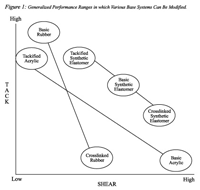Featured Stories
-
Innovation in Extrusion Barriers Can Reduce Brand Owners’ Dependence on Plastic
According to the most recent statistics from the Environmental Protection Agency1, in 2018 the U.S. produced 35 million tons of plastics, while... -
Tension: The First Thing We Must Get Right
Web tension is arguably the most important parameter for any web process. Tension is the first thing we must get right. -
Principles of Narrow Web Slitting
For those veterans in the slitting-winding community, this commentary is not necessarily new information, but reviews are always good too.
News | New Products
-
TIPA Compostable Packaging Appoints John Wilson as Commercial Director for North America
Packaging and sustainability industry veteran joins TIPA, to drive US adoption of compostable packaging to curb plastic waste
-
INX promotes three to Vice President positions
The Board of Directors at INX International Ink Co. have approved the promotions of three key executive managers to vice president positions.
-
Rogelio Barba Villagran Named Business Development Director for AGH Labels North America
AGH Labels, headquartered in Leon, Mexico, is excited to announce long-time executive, Rogelio Barba Villagran, as its business development director for AGH Labels North America.
-
Hong Kong PrintPack Fairs Open in April
Jointly organized by the Hong Kong Trade Development Council and CIEC Exhibition Company (HK) Limited, the two PrintPack Fairs will be April 27-30, 2024 at AsiaWorld-Expo
-
BioEmitter®- Keeping Corrosion and Rust at Bay in Enclosed Spaces
One of the most important missions of Cortec® Corporation, a global leader in the corrosion protection industry, is environmental responsibility.
-
Fedrigoni Names New Commercial Senior Vice President, Chief Marketing Officer
Fedrigoni — the world’s leading manufacturer of specialty papers, premium self-adhesive materials, RFID and connected solutions
-
SEI integrates Vetaphone on new Labelmaster KyoJet
SEI Laser Converting is based in Buja in the northeast corner of Italy.
Expert Advice
How To Choose the Best Adhesive System
- Published: March 26, 2008, By By Mike McLain, Jessup Mfg. Co.
How To Choose the Best Adhesive System
By Mike McLain, Jessup Mfg. Co.
Create a competitive product advantage by avoiding adhesive system stereotypes.
Many companies put themselves at a competitive disadvantage by limiting adhesive systems choices based on performance stereotypes rather than considering the many individualized technologies that are available. Simply making a choice from one of the four basic resin categories or two general processing methods fails to take into account the many variations in performance that are now possible through the use of additives or special curing processes that can increase the cost/performance ratio. This article is intended to provide a better understanding of engineering decisions when evaluating adhesive systems for specific product needs.
Engineering
Relying on stereotypes, such as “acrylics always have lower tack properties” or “hot melts have poor performance,” can create traps for companies when engineering products. There are many reasons a company might fall into a stereotyping trap, such as:
- Lack of expertise and technical knowledge of individual coating packages.
- Relying on a past experiences to generalize that the adhesive or process category, not the engineering choices, were responsible for failure or success.
- Relying too heavily on suppliers that focus more on what they have to sell and less on what is best for the product’s success.

To avoid these traps, companies should ensure they maximize the use of high quality product engineers, both internally and externally. A good supplier and/or a good consulting firm can greatly add to a company’s engineering capability. Obviously, it always helps to purchase from suppliers that can provide a high level of product engineering and who have a wide range of both product and process technology to choose from.
This is not to say that one should not utilize past trends and information as starting points in the engineering process. However, buyers need to be careful not to eliminate any technology based on assumptions rather than the specific product needs.
Coating Chemistry
There is often a lot of confusion in the choice of coating chemistry because there are so many specialized resins offered in each category. Often buyers will simply group adhesives in one of four basic resin categories:
- Natural Rubbers
- Synthetic Elastomers
- Acrylics
- Specialty—Silicones, Phenolics, etc.
Dependable engineering advice is crucial in order to make correct decisions about the best resin. This is because each category of resin includes a unique compound with the ability to offer a specific trait that the product needs. Furthermore, additional enhancements typically are possible through the use of additives.
In generalized terms, acrylics tend to offer better clarity, UV resistance, and hardness. Rubbers tend to offer higher adhesion properties, anchorage to a wider range of surfaces, and better softness/flow. However, through the use of additives, new properties can be created for specific situations. A unique group of synthetic polymers, sometimes referred to as synthetic elestomers, actually offer a blend of the rubber and acrylic properties. This unique polymer offers the higher shears and heat stability prevalent in acrylics, as well as the higher tack and adhesion properties of rubbers.
The choice of additives has a large impact on determining the base resin choice to meet the demands for a specific product requirement. Therefore, engineering expertise is necessary in finding the optimal balance needed. For instance, using additives to achieve the high tack properties in acrylics will almost always reduce the typical high creep-related properties of acrylics, such as shear, heat resistance, and chemical resistance. Figure 1 shows some of the performance ranges and impact of certain additives.
Coating Systems
Once the best adhesive is identified, correct processing methods are required to ensure the properties are achieved in the end product. There are several processing methods available, but this article will categorize them as 100% solid technologies and solution technologies. It should be noted that coating system technology is greatly influenced by machinery capability over that of final product performance.
Solution coated systems typically have seen greater advancement because of the age of the technology and ease of processing. The technology required for solution coating can be fairly simple and has been around for decades. Another big advantage of solution is that it is easier to blend additives to meet specific demands of not only the machine but the product. These are among the many reasons there has been much more research performed over the years on solution systems resulting in a large array of technical options. Since there are so many choices, it is vital to work with internal and external engineers to understand the technology not only affecting the adhesive’s outward properties (such as peel and shear), but also deeper properties that make each specific adhesive’s performance unique.
Until recently, 100 % solid technologies such as hot melt typically have been driven by the cost. Today, many other factors, such as environmental sustainability and energy costs, are coming into play to increase attention to these systems. However, there has not been a great deal of technical research devoted to these systems, and the variety of performance choices tends to lag behind that of solution systems. To make up for the lack of technical research in this field, while still capturing the technology’s lower costs, certain performance characteristics are disguised by the use of higher coat weights, sometimes exceeding 0.004-in. (4 mils) in thickness.
However, unless the thickness is needed to ensure surface contact on an irregular or porous surface, this can become a way of simply disguising a poor engineering choice to satisfy equipment capability over that of the product needs. Today, there are more choices that allow hot melts to be formulated for good performance at the 1-2 mil dry caliper range. The advent of new technologies such as UV and EB curing has offered some advances in this field. As the cost of oil continues to climb, even more research likely will be justified in order to eliminate the rising costs of solvents. However, the current tradeoff for this performance is a higher price for equipment and technology over that of typical hot melt systems.
Choosing the Right Adhesive System
It is important to approach decisions about adhesive systems with an open mind, rather than thinking about the problem as strictly acrylic vs. rubber or hot melt vs. solution. Making choices in this way not only limits the options but is more likely to cause the decision to be based on capability instead of product excellence. The best way to choose the best adhesive system is to do the following:
- Know your product and its use. One of the biggest mistakes companies make is not knowing their product requirements at every level. Surface types, exposure conditions, shelf life, substrate type, and similar factors are all critical considerations.
- Request performance properties not adhesive stereotypes. Starting with performance characteristics allows the product engineers more latitude to find or develop adhesives that are capable of meeting the product requirements. This will avoid the trap allowing the stereotype to control the product instead of the product requirements dictating the solution.
- Deal with companies that have strong product engineering groups. The product company does not have to be an expert on the available adhesive systems as long as they work with suppliers and consultants that can provide the engineering, expertise, and equipment to make quality recommendations.
- Test for quality assurance. Make sure that once the adhesive has been identified, the company providing it has the ability to control the properties that are needed to assure consistent, repeatable performance.
Following these steps will help ensure that the adhesive system is the right choice for the particular application.
Mike McLain is engineering and R&D manager of Jessup Mfg. Co., responsible for technical development of products, specifications, and environmental compliance. He has been in product development at Jessup for 14 years and has been developing products in the coating industry for 20 years. Mike has been responsible for the development or improvement for many of Jessup’s current products and has successfully brought 100 custom-coated products to realization through Jessup’s custom-coating business. He received his undergraduate degree in Automated Manufacturing Technology and is currently completing his Masters in Environmental Management. Contact him at 815-385-6650 or This email address is being protected from spambots. You need JavaScript enabled to view it..













